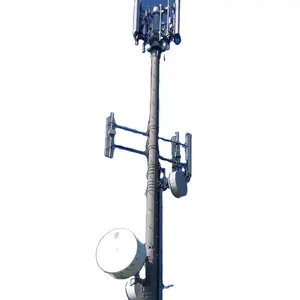
All categories
Featured selections
Trade Assurance
Buyer Central
Help Center
Get the app
Become a supplier

(946 products available)





































The price of self supporting towers varies greatly depending on the type of tower. Here are some common types of self-supporting towers and their price ranges:
Telecommunication Towers:
These are lattice towers built for telecommunication purposes, including mobile phone networks and internet service providers. Their prices vary based on the height and load capacity. For instance, a 30-meter lattice telecommunications tower might cost between $15,000 and $25,000. Moreover, a 40-meter tower can range from $20,000 to $35,000.
Electricity Transmission Towers:
Self-supporting transmission towers are used to support overhead power lines. The cost of these towers depends on factors such as the tower's span length and the voltage transmission capacity. For example, a 110 kV self-supporting transmission tower can cost between $50,000 and $80,000. Additionally, a 220 kV tower might range from $80,000 to $120,000.
Wind Energy Towers:
These towers support wind turbines. Their prices depend on the height of the tower and the turbine's capacity. For instance, a self-supporting wind energy tower for a 1 MW turbine might cost between $200,000 and $300,000. Moreover, for a 2 MW turbine, the price can range from $300,000 to $500,000.
Satellite Dish Towers:
These are used to hold satellite dishes for broadcasting or receiving signals. The cost of these towers depends on the size of the satellite dish and the height of the tower. For example, a self-supporting tower for a small satellite dish might cost between $2,000 and $5,000. Conversely, for a large satellite dish, the price can range from $5,000 to $10,000.
Monitoring and Observation Towers:
These towers are built for purposes such as coastal monitoring or wildlife observation. Prices depend on their height and the platform's size at the top. For example, a 20-meter self-supporting observation tower might cost between $10,000 and $15,000. Additionally, a 30-meter tower can range from $15,000 to $25,000.
Self supporting towers price varies based on the application and material used. These towers are used in various industries and some of the applications include;
The self-supporting tower price varies depending on several factors. Here are some key factors that affect the price:
Self-supporting towers come in different designs, features, and functions. Below are some of them:
Climbing A-Frame Towers
These towers are designed to allow users to safely climb to their height for maintenance or other purposes. They usually have steps or rungs that provide support when climbing. These steps are designed in a way that ensures users are safe and minimizes the risk of falling. Climbing A-frame towers are commonly used in applications where regular maintenance or access is required, such as radio, telecommunications, or agricultural towers.
Triangular Self-Supporting Towers
These come with three legs that form a triangular shape. This design provides excellent stability and strength. It is also very efficient in wind loads, which makes it a popular choice for many applications. Triangular self-supporting towers are commonly used for telecommunications, power transmission, and other applications where a sturdy and reliable support structure is needed. Additionally, these towers can be easily manufactured and erected, making them a cost-effective option for many projects.
Collapsible Self Supporting Towers
These towers can be folded down for easy transportation and storage. They are designed with hinged sections that can be lowered and locked into place, creating a compact unit. This design makes collapsible self-supporting towers an excellent choice for applications where portability is essential, such as temporary communication setups for events or emergency situations.
Square Self Supporting Towers
These structures have a square tubular profile, which adds to their strength and stability. The square shape allows for easy mounting of equipment on all sides of the tower. This design provides excellent wind load capacity and is used in various applications, including broadcasting, surveillance, and as wind measurement towers in meteorological stations.
Q1: How to determine the right self-supporting tower for a project?
A1: To choose the correct self-supporting tower, several factors must be considered, such as the tower's height, load capacity, environmental conditions, and intended use. Conducting a thorough site survey and consulting with industry experts can help ensure the right choice is made for specific needs and requirements.
Q2: What are the maintenance requirements for self-supporting towers?
A2: Self-supporting towers require regular maintenance to ensure their longevity and optimal performance. This includes routine inspections to check for signs of rust, corrosion, or physical damage; tightening bolts and connections; and ensuring that no debris or obstructions are present on the tower or its components.
Q3: Can self-supporting towers be installed in challenging terrains?
A3: Self-supporting towers can be installed in challenging terrains, but doing so requires careful planning and specialized equipment. In difficult terrain, additional measures such as reinforced concrete bases, increased foundation depth, and erosion control strategies may be necessary to ensure the tower's stability and longevity.
Q4: How do self-supporting tower prices compare to other types of towers?
A4: Self-supporting tower prices vary based on factors such as material, height, load capacity, and manufacturer. While self-supporting towers may have a higher upfront cost than other types of towers, such as monopole or guyed towers, their long-term benefits, including reduced maintenance costs and increased reliability, often outweigh the initial investment.
Q5: What factors affect the load capacity of a self-supporting tower?
A5: Several factors affect a self-supporting tower's load capacity, including the tower's design, materials, height, and environmental factors such as wind speed and ice accumulation. The load capacity is crucial for ensuring the tower can support its intended antennas, equipment, and any future additions.